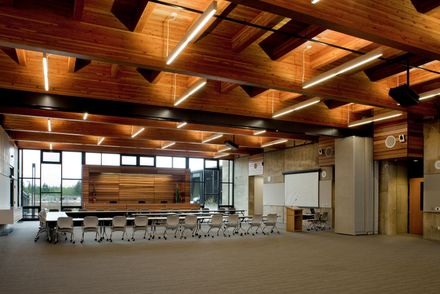
John’s Prairie Operations Center
ARCHITECTS
Tcf Architecture
MANUFACTURERS
Aep Span, Atas International, Capital Lumber, Miles Sand And Gravel
PROJECT TEAM
Gerry Pless, Mark Hurley, Jeremy Wooley, Ryan Miller
STRUCTURAL ENGINEER
Pcs Structural Solutions, Owen Bower, Brian Phair
MECHANICAL ENGINEER
Interface Inc, Andy Frichtl
LANDSCAPE ARCHITECT
The Berger Partnership, Steve Shea
ENVELOPE CONSULTANT
Bill Cypher - Wetherholt & Associates
PHOTOGRAPHS
Pete Eckert
ACOUSTICAL ENGINEERING
Ssa Acoustics, Bill Stewart
LEAD ARCHITECTS
Randy Cook, Brian Ho
CIVIL ENBGINEER
Pyramid Engineers Llc, Peter Gonzales
ELECTRICAL ENGINEER
Interface Inc, David Chesley
LEAD DESIGNER
Chris Johnson
AREA
142000 Ft²
LOCATION
Shelton, United States
CATEGORY
Industrial Architecture
YEAR
2013
Text description provided by the architects.
Mason County PUD No. 3’s new administrative, maintenance and operations facility unites all of the PUD’s functions within a state-of-the-art, highly professional campus.
The staff of the John’s Prairie Operations Center and citizens of the surrounding community are pleased to have contributed toward the improvement of County infrastructure by supporting those who maintain local electrical utilities.
At the onset of the project, a comprehensive study weighed the impacts of maintaining existing conditions - a widely-dispersed collection of aging structures and leased office space – with the benefits of building new.
As a part of the cost-benefit analysis, operational procedures and interdepartmental logistics were studied, including daily work tasks of line crew, technicians, customer service, administrative, vehicle maintenance, and warehouse personnel.
The culmination of this phase made apparent to the design team the economic and cultural benefits of creating a single facility on a centrally-located PUD-owned parcel.
As a result of substantially improved labor time and fuel/energy efficiencies, as well as increased productivity, the cumulative savings between a consolidated operation and decentralized, separate facilities, was estimated at more than $60 million over a projected 50-year period
Design of the $25 million, five building, 146,000 sqft operations campus followed, providing a new home for over 115 staff and crew on a 22-acre parcel.
Treading lightly, the John’s Prairie Operations Center responds to the County’s goals for low-impact site development, and conservation of water and energy.
Harvested rain supplies water for irrigation and toilet flushing. A 225 kW photovoltaic (PV) array atop shop building “D” harvests the sun’s rays, supplementing electricity within the power grid. Infrastructure is in place for the eventual conversion to Net Zero Energy through additional solar panel installation.
Architecturally, the campus utilizes the durable and regionally-appropriate materials of concrete, steel, masonry and heavy timber. A stately civic building serves as the “front door” to the campus, with a high-volume, two story entry mass separating the public and private zones.
Comprised of more industrial materials for industrial functions, the private zone is clad in masonry and steel, while the public area is characterized by its ample use of wood finish.
The auditorium, framed by heavy timber reminiscent of the area’s timber industry, offers the use of community gathering space and safe shelter in the event of an emergency.
Beyond the walls of the administration building, thoughtful planning provides visibility and transparency in and among the material staging and warehousing, specialty workshops, vehicle and equipment storage and the fuel /wash spaces; simple, logical, building and site circulation place user safety at the forefront.
Crew facilities - such as dispatch, locker and mud rooms –promote daily interaction to enhance worker morale, which in turn, leads to increased productivity and employee retention.
Quality detailing and consistent use of materials throughout the campus provide a professional, elegant atmosphere for all department members.
Interiors are awash in daylight, and the local, renewable and non-toxic attributes of finishes help create a healthy, productive work environment for all PUD employees.






















